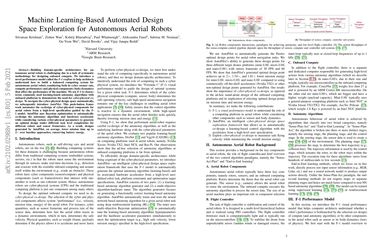AutoPilot: Automating SoC Design Space Exploration for SWaP Constrained Autonomous UAVs
Building domain-specific accelerators for autonomous unmanned aerial vehicles (UAVs) is challenging due to a lack of systematic methodology for designing onboard compute. Balancing a computing system for a UAV requires considering both the cyber (e.g., sensor rate, compute performance) and physical (e.g., payload weight) characteristics that affect overall performance. Iterating over the many component choices results in a combinatorial explosion of the number of possible combinations: from 10s of thousands to billions, depending on implementation details. Manually selecting combinations of these components is tedious and expensive. To navigate the {cyber-physical design space} efficiently, we introduce \emph{AutoPilot}, a framework that automates full-system UAV co-design. AutoPilot uses Bayesian optimization to navigate a large design space and automatically select a combination of autonomy algorithm and hardware accelerator while considering the cross-product effect of other cyber and physical UAV components. We show that the AutoPilot methodology consistently outperforms general-purpose hardware selections like Xavier NX and Jetson TX2, as well as dedicated hardware accelerators built for autonomous UAVs, across a range of representative scenarios (three different UAV types and three deployment environments). Designs generated by AutoPilot increase the number of missions on average by up to 2.25x, 1.62x, and 1.43x for nano, micro, and mini-UAVs respectively over baselines. Our work demonstrates the need for holistic full-UAV co-design to achieve maximum overall UAV performance and the need for automated flows to simplify the design process for autonomous cyber-physical systems.
PDF Abstract
